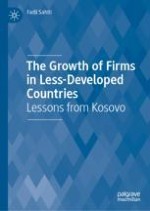2019 | OriginalPaper | Buchkapitel
5. An Analysis of the Business Environment in Kosovo Using Growth Diagnostics Approach
verfasst von : Fadil Sahiti
Erschienen in: The Growth of Firms in Less-Developed Countries
Aktivieren Sie unsere intelligente Suche, um passende Fachinhalte oder Patente zu finden.
Wählen Sie Textabschnitte aus um mit Künstlicher Intelligenz passenden Patente zu finden. powered by
Markieren Sie Textabschnitte, um KI-gestützt weitere passende Inhalte zu finden. powered by
